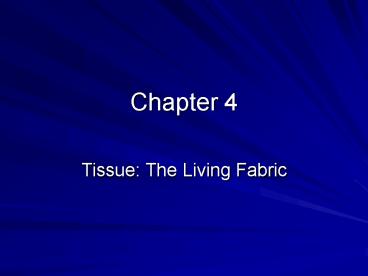Tissue: The Living Fabric - PowerPoint PPT Presentation
1 / 24
Title:
Tissue: The Living Fabric
Description:
Chapter 4. Tissue: The Living Fabric. Tissues. Groups of cells similar in structure ... CHECK GRADE Mean 69% Median 75-85% Look at the number next to the T ... – PowerPoint PPT presentation
Number of Views:85
Avg rating:3.0/5.0
Title: Tissue: The Living Fabric
1
Chapter 4
- Tissue The Living Fabric
2
Tissues
- Groups of cells similar in structure and function
- The four types of tissues
- Epithelial
- Connective
- Muscle
- Nerve
3
- Next time leave section open for late commers
- Less distraction
- Bubble In one side,
- Name on both sides saves me lots of time
- Privacy
- Reading from bubble
- CHECK GRADE Mean 69 Median 75-85
- Look at the number next to the T
- Add 1 to it I GAVE EVERYONE ONE MORE RIGHT
- Divide number by 75
- Multiply by 100
- Add extra credit
4
Epithelial Tissue
- Cellularity composed almost entirely of cells
- Special contacts form continuous sheets held
together by tight junctions and desmosomes - Polarity apical and basal surfaces
- Supported by connective tissue reticular and
basal laminae - Avascular but innervated contains no blood
vessels but supplied by nerve fibers - Regenerative rapidly replaces lost cells by
cell division
5
Epithelial Tissue
- Cellularity composed almost entirely of cells
- Special contacts form continuous sheets held
together by tight junctions and desmosomes - Polarity apical and basal surfaces
- Supported by connective tissue reticular and
basal laminae - Avascular but innervated contains no blood
vessels but supplied by nerve fibers - Regenerative rapidly replaces lost cells by
cell division
6
Classification of Epithelia
- Simple or stratified
7
Classification of Epithelia
- Squamous, cuboidal, or columnar
8
Simple SquamousEpithelia
- Single layer of flattened cells with disc-shaped
nuclei and sparse cytoplasm - Functions
- Diffusion and filtration
- Provide a slick, friction-reducing lining in
lymphatic and cardiovascular systems - Present in the kidney glomeruli, lining of heart,
blood vessels, lymphatic vessels, and serosae
9
Simple CuboidalEpithelia
- Single layer of cubelike cells with large,
spherical central nuclei - Function in secretion and absorption
- Present in kidney tubules, ducts and secretory
portions of small glands, and ovary surface
10
Simple ColumnarEpithelia
- Single layer of tall cells with oval nuclei many
contain cilia - Goblet cells are often found in this layer
- Function in absorption and secretion
- Nonciliated type line digestive tract and
gallbladder - Ciliated type line small bronchi, uterine tubes,
and some regions of the uterus - Cilia help move substances through internal
passageways
11
Pseudostratified Columnar Epithelia
- Single layer of cells with different heights
some do not reach the free surface - Nuclei are seen at different layers
- Function in secretion and propulsion of mucus
- Present in the male sperm-carrying ducts
(nonciliated) and trachea (ciliated)
12
Stratified Squamous Epithelia
- Thick membrane composed of several layers of
cells - Function in protection of underlying areas
subjected to abrasion - Forms the external part of the skins epidermis
(keratinized cells), and linings of the
esophagus, mouth, and vagina (nonkeratinized cells
13
Stratified Cuboidal and Columnar Epithelia
- Stratified cuboidal
- Quite rare in the body
- Found in some sweat and mammary glands
- Typically two cell layers thick
- Stratified columnar
- Limited distribution in the body
- Found in the pharynx, male urethra, and lining
some glandular ducts - Also occurs at transition areas between two other
types of epithelia
14
Transitional Epithelia
- Several cell layers, basal cells are cuboidal,
surface cells are dome shaped - Stretches to permit the distension of the urinary
bladder - Lines the urinary bladder, ureters, and part of
the urethra
15
Glandular Epithelia
- A gland is one or more cells that makes and
secretes an aqueous fluid - Classified by
- Site of product release endocrine or exocrine
- Relative number of cells forming the gland
unicellular or multicellular
16
Endocrine Glands
- Ductless glands that produce hormones
- Secretions include amino acids, proteins,
glycoproteins, and steroids
17
Exocrine Glands
- More numerous than endocrine glands
- Secrete their products onto body surfaces (skin)
or into body cavities - Examples include mucous, sweat, oil, and salivary
glands - The only important unicellular gland is the
goblet cell - Multicellular exocrine glands are composed of a
duct and secretory unit
18
Multicellular Exocrine Glands
- Classified according to
- Simple or compound duct type
- Structure of their secretory units
19
Structural Classification of Multicellular
Exocrine Glands
20
Modes of Secretion
- Merocrine products are secreted by exocytosis
(e.g., pancreas, sweat, and salivary glands)
21
Modes of Secretion
- Holocrine products are secreted by the rupture
of gland cells (e.g., sebaceous glands)
22
Connective Tissue
- Found throughout the body most abundant and
widely distributed in primary tissues - Connective tissue proper
- Cartilage
- Bone
- Blood
23
Connective Tissue
24
Characteristics of Connective Tissue
- Connective tissues have
- Mesenchyme as their common tissue of origin
- Varying degrees of vascularity
- Nonliving extracellular matrix, consisting of
ground substance and fibers































